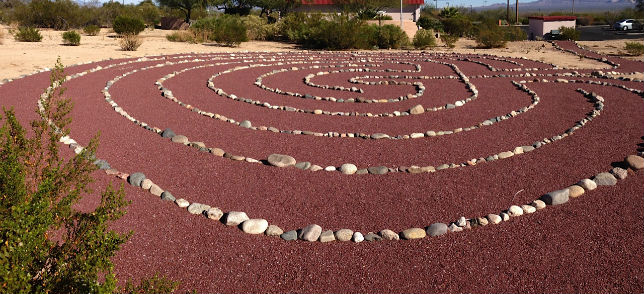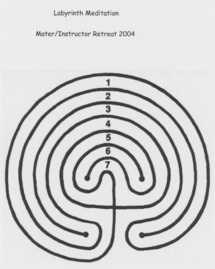The Unity in the Valley Church labyrinth was dedicated on May 13, 2014. The congregation’s labyrinth committee of Tom Coleman, Steve Otrosa, Elaine Wood, and Julio Morales worked hard to bring forth the final design and present it to the congregation. In response, the congregation generously contributed the money needed for the construction of the labyrinth design on church grounds adjacent to the flagpole and Memorial Garden patio area.

A labyrinth is an ancient path of prayer, one of many spiritual tools to bring us closer to God. The twists and turns of the labyrinth are metaphors for our own individual spiritual journeys. The labyrinth can be traced back as far as 4,500 years, and perhaps the most famous and celebrated example is the labyrinth set into the floor stones in the nave of the Cathedral at Chartres and known as the “Road to Jerusalem.” The symbolic spiritual journey of walking the labyrinth came from necessity, because during the crusades it was dangerous and almost impossible to make a pilgrimage to the Holy land. (Source: Helen Russell, Tucson authority on labyrinths)
For the Medieval pilgrims, the path of the labyrinth symbolically led to their final destination, the New Jerusalem. For today’s pilgrim, the path leading out from the center of the labyrinth returns us to the daily challenges the outside world has created for us. Read on for suggestions on how to enjoy the labyrinth walk at Unity and how a labyrinth walk can be used as a method of problem solving.
The labyrinth on the Unity in the Valley Church grounds is open 24/7 to the general public and all are welcome. No appointment is needed. No membership is required.
How to Enjoy a Labyrinth Walk
It is helpful to mute electronic devices and silently walk around the outside of the labyrinth to quiet your mind.
Walkers are encouraged to enter into a meditative or prayerful state: stay open to the divine as you begin.
When the time feels right, enter the labyrinth. Wander along the pathway, taking care to stay on the path. Do not cross the lines except to let someone pass. Feel free to move at your own pace, stopping anywhere that feels right for you.
Many people bring or wear sacred objects on their walk. Some chant or drum while walking. When you reach the center of the labyrinth, stop and meditate or pray if you feel so inclined.
Walking a labyrinth is one way to experience a powerful ancient symbol with your whole body. You can walk alone or not: but as in life, no matter how many people join you, your trip is singularly your own. A trip around the labyrinth may do no more than clear your head and temporarily quiet your chattering mind, or it may be a moving spiritual experience. There is no right or wrong way, no special formula. All experiences are perfect for the person and the moment.
Please feel free to use the benches or the patio area to sit and process your experience and/or record it in your journal. (Sources: Mary Rose O’ Reilley, Unity, and Helen Russell, Tucson authority on labyrinths)
The Labyrinth Walk as a Method of Problem Solving
The three basic parts of the labyrinth are the entrance, the circuits, and the center. Let’s take a "walk" through the labyrinth and see how this works. Come with me to the entrance, pause here and think of a problem or concern. It is important that you stay open to receiving a solution. The labyrinth is entered on circuit number 3. Begin at the entrance and start "walking.” Walk at a slow pace, not stopping until you reach the center. Each path (circuit) is associated with a feeling or attitude about the problem or concern.
Circuit 1 - I will explore how this problem affects me in my physical world.
Circuit 2 - I will explore what "I feel.” What emotions do you feel about this problem?
Circuit 3 - I will explore what "I think" about the problem.
Circuit 4 - How does this affect my spiritual life? Will it help you grow or inhibit you?
Circuit 7 - Ask God to walk with you. Place the problem in the hands of God and be thankful.
Circuit 6 - Ask for vision - a solution to your problem. When it comes, accept it without judgment. Accept the idea of a solution that you have been given.
Circuit 5 - Ask yourself, "What is the first step?" Let it come.
Goal (Center) - This is the place for simply pausing and letting the solution you have been given settle in. Just be with it. This is the first half of your walk.
 Circuit 5 - Look with non-judgment at the first step you were given.
Circuit 5 - Look with non-judgment at the first step you were given.
Circuit 6 - Keep looking in a non-judgmental way at the answer you were given.
Circuit 7 - Thank God for giving you this awareness.
Circuit 4 - How will this solution affect your spiritual life? Will it either help you grow or inhibit you?
Circuit 3 What do you think about the solution? If it still just doesn't seem like the right solution, try walking it again, later.
Circuit 2 - How does this solution make you feel?
Circuit 1 - How will this solution affect your physical life? How will it affect your body, your health?
Back at the entrance to the labyrinth, turn and give thanks for the guidance you received. Notice how you feel as you emerge from the labyrinth. Use the labyrinth as a helpful tool for growth!
Please feel free to use the benches or the patio area to sit and process your experience and/or record it in your journal. The labyrinth on the Unity in the Valley Church grounds is open 24/7 to the general public and all are welcome. No appointment is needed. No membership is required.
